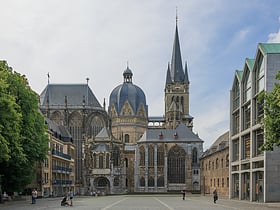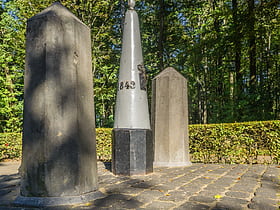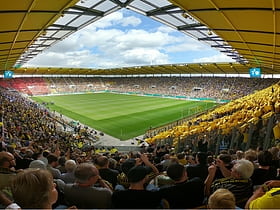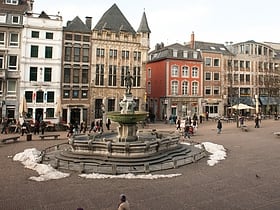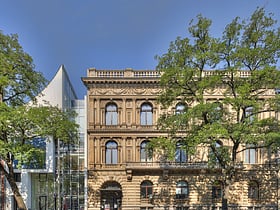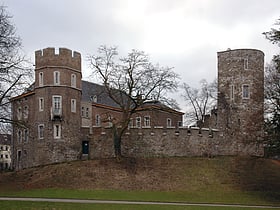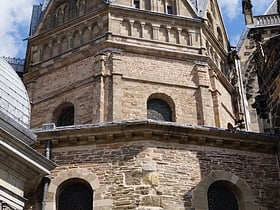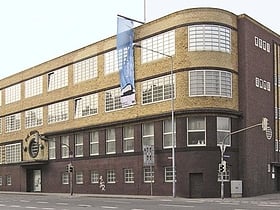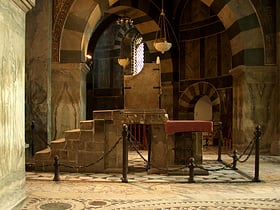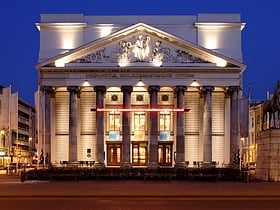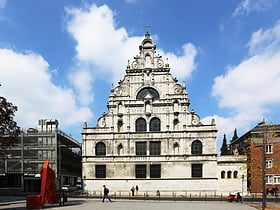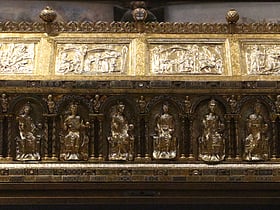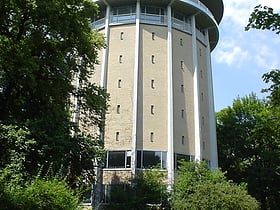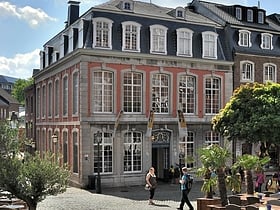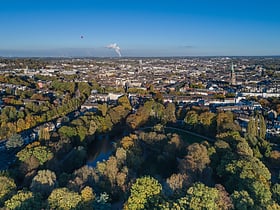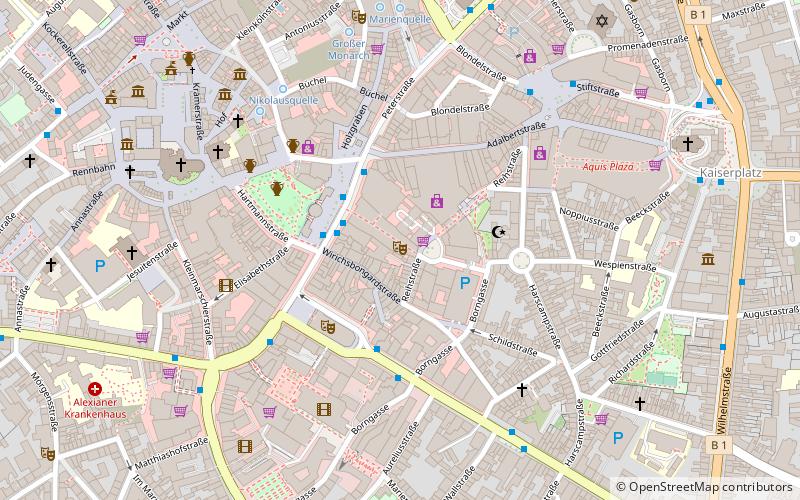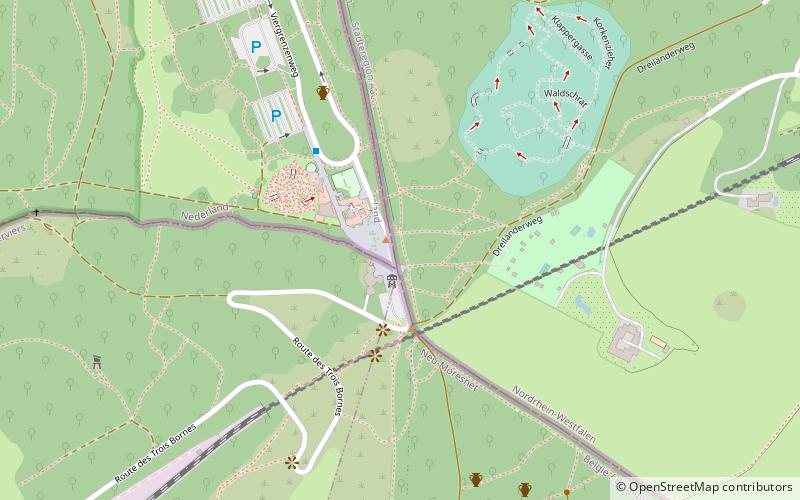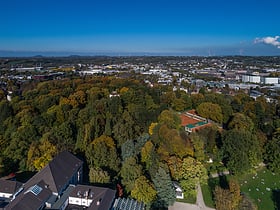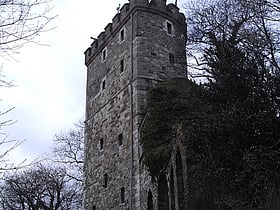Aachen: Sightseeing
Places and attractions in the Sightseeing category
Categories
- Church
- Gothic architecture
- Museum
- Park
- Fountain
- Carolingian architecture
- History museum
- Concerts and shows
- Tower
- Forts and castles
- Cemetery
- Memorial
- Sightseeing
Aachen Cathedral
Iconic cathedral and Charlemagne's chapel Aachen Cathedral, a masterpiece of medieval architecture, stands as a testament to the city's historical significance and religious heritage. Constructed by order of Emperor Charlemagne in the late 8th century, it was the first German building to be listed as a UNESCO...
City Hall
Town hall hosting replica crown jewels The Aachen City Hall stands as an architectural testament to the city's rich history and cultural heritage, located in the heart of Aachen, Germany. The building, with its distinctive Gothic façade, was built on the foundation of the Carolingian palace of Charlemagne...
Vaalserberg
Nestled within the city of Aachen, Germany, Vaalserberg stands as a notable geographic landmark. This hill, modest in stature yet rich in significance, rises to an elevation of 322.7 meters above sea level, making it a prominent feature in the otherwise gentle...
Tivoli
Nestled within the vibrant city of Aachen, Germany, Tivoli is a sports venue that garners the attention of football enthusiasts and sports fans alike. Known primarily as the home ground for Alemannia Aachen, a traditional football club, Tivoli stands as a modern...
Statue of Charlemagne
Standing proudly in the historic city of Aachen, Germany, the Statue of Charlemagne is not only a tribute to one of Europe's greatest medieval rulers but also a prominent centerpiece as a fountain, reflecting the city's rich heritage.
Ponttor
Imposing, 14th-century city gate Nestled within the historic city of Aachen, Germany, stands the Ponttor, a proud remnant of the medieval fortifications that once encircled the city. This impressive city gate, integrated into Aachen's ancient city wall, is an enduring symbol of the city's rich past...
Suermondt-Ludwig-Museum
Nestled in the historic city of Aachen, Germany, the Suermondt-Ludwig-Museum is a cultural gem that beckons art enthusiasts and history buffs alike. This museum, named after the Aachen businessman Barthold Suermondt and the Ludwig family of Aachen, houses a rich...
Frankenberg Castle
Frankenberg Castle, nestled in the historic city of Aachen, Germany, stands as a testament to the region's medieval heritage. This venerable fortress, with its robust walls and imposing towers, offers a glimpse into the architectural prowess of a bygone era.
Palatine Chapel
The Palatine Chapel, nestled in the heart of Aachen, Germany, stands as a monumental testament to the city's rich historical tapestry. This octagonal chapel forms the core of the Aachen Cathedral, a UNESCO World Heritage site, and is renowned for its remarkable...
Ludwig Forum für Internationale Kunst
Museum showcasing modern and pop art Nestled in the historic city of Aachen, Germany, the Ludwig Forum für Internationale Kunst stands as a beacon of contemporary art and culture. This museum, located in a repurposed umbrella factory, is a dynamic space that showcases a diverse collection of modern art...
Kornelimünster Abbey
Kornelimünster Abbey, also known as Abbey of the Abbot Saint Benedict of Aniane and Pope Cornelius, is a Benedictine monastery that has been integrated since 1972. The abbey is located in Aachen in North Rhine-Westphalia in Germany.
Throne of Charlemagne
The Throne of Charlemagne is a throne erected in the 790s by Charlemagne, as one of the fittings of his palatine chapel in Aachen and placed in the Octagon of the church. Until 1531, it served as the coronation throne of the Kings of Germany, being used at a total of thirty-one coronations.
Aachen Cathedral Treasury
The Aachen Cathedral Treasury is a museum of the Roman Catholic Diocese of Aachen under the control of the Cathedral chapter, which houses one of the most important collections of medieval church artworks in Europe.
Theater Aachen
Theater Aachen is a theatre in Aachen, Germany. It is the principal venue in that city for operas, musical theatre and plays. It is the home of the Aachen Symphony Orchestra. Construction on the original theatre began in 1822 and it opened on 15 May 1825.
St. Michael's Church
St. Michael's is a church in Aachen, Germany. It was built as a church of the Aachen Jesuit Collegium in 1628, later it was a Catholic parish church and is now a church of the Greek Orthodox Metropolis of Germany. The official name today is Church of Archangel Michael – St Dimitrios.
Karlsschrein
The Karlsschrein is located in Aachen Cathedral and contains the remains of Charlemagne. It was completed in 1215 in Aachen at the command of Frederick II, Holy Roman Emperor.
Belvedere Water Tower
The Water Tower Belvedere is a water tower of reinforced concrete construction in Aachen, Germany, located on the Lousberg hill. It was built in 1956. The water tower accommodates a revolving restaurant, which reopened in 2005 after being closed for several years. The restaurant revolves once every 56 minutes.
Couven-Museum
Haus Monheim is a listed building in the old town of Aachen. It was a residential and commercial building of the Monheim family of pharmacists and is one of Jakob Couven's surviving works in Aachen.
Öcher Schängche
Öcher Schängche is a puppetry theatre in Aachen, North Rhine-Westphalia, Germany. It was founded by Will Hermanns and others in 1921.
Westpark
The Westpark is a park in the west of Aachen, which is bounded by Gartenstraße, Welkenrather Straße and Vaalser Straße.
Antoniuskapelle
St. Anthony's Chapel is located in Kornelimünster/Walheim, a district of the German city of Aachen. The chapel was built in 1718 but destroyed by an earthquake before consecration. Charles Ludwig von Sickingen-Ebernburg, the abbot of the abbey at Kornelimünster later ordered to rebuild the damaged unfinished building.
Grenzlandtheater Aachen
Grenzlandtheater Aachen is a theater in Aachen, North Rhine-Westphalia, Germany founded by actor Kurt Sieder in 1950.
Bismarck Tower
The Aachen Bismarck Tower is one of 173 still-standing towers and columns, which were constructed in the German Empire to commemorate the founder of the German state, Otto von Bismarck.
Cross of Lothair
The Cross of Lothair or Lothair Cross is a crux gemmata processional cross dating from about 1000 AD, though its base dates from the 14th century. It was made in Germany, probably at Cologne.
Germany–Netherlands border
The Germany–Netherlands border consists of a 570-kilometre land and maritime border across the Dollart through the Frisian Islands into the North Sea.
International Newspaper Museum
The International Newspaper Museum in Aachen presents the history of newspapers and the subject of press history.
Marienschrein
The Marienschrein in Aachen Cathedral is a reliquary, donated on the order of the chapter of Mary around 1220 and consecrated in 1239.
RWTH Aachen University
RWTH Aachen University or Rheinisch-Westfälische Technische Hochschule Aachen is an elite German public research university located in Aachen, North Rhine-Westphalia, Germany.
Würselen
Würselen is a town in the borough of Aachen, in North Rhine-Westphalia, Germany.
Aachener Tierpark Euregiozoo
The Aachen Zoo Euregiozoo is an 8.9-hectare zoo located between the districts of Forst and Beverau in Aachen's "Drimborner Wäldchen", named after the former family of aldermen mayors Hermann von Dremborn and Johann von Drimborn.
Herz-Jesu
The Catholic Church of the Sacred Heart, colloquially known as Frankenberg Cathedral or Öcher Sacre Coeur, was built between 1908 and 1910 as a neo-Romanesque ashlar basilica designed by architect Josef Kleesattel in the Frankenberg quarter ...
CHIO Aachen
The CHIO Aachen is a popular international horse show held in Aachen, Germany, each summer.
St. Foillan
St. Foillan is one of the city parish churches in Aachen. It is located in the area of the pedestrian zone and is separated from the cathedral only by a narrow alley. It is the only church in the German-speaking area which was placed under the...
Stadtgarten
The Stadtgarten Aachen with the central and 193 m above sea level Wingertsberg is a landscaped urban park in Aachen. It is composed of the hospital garden created in 1852, which was redesigned as a spa park from 1916, as well as the adjoining...
Proserpina sarcophagus
The Proserpina sarcophagus is a Roman marble sarcophagus from the first quarter of the third century AD, in which Charlemagne was probably interred on 28 January 814 in Aachen cathedral. It is displayed today in the Aachen Cathedral Treasury.
St. Adalbert
The Provost Church of St. Adalbert in Aachen was the collegiate church of a collegiate foundation and was consecrated in 1005. It is thus the second oldest church in the city after Aachen Cathedral. St.
Grabeskirche St. Josef
St. Josef in Aachen is a former Catholic parish church that is now used as a columbarium for urn burials under the name "Grabeskirche", partly because the neighboring Aachen East Cemetery has reached the limits of its...
Elisa Fountain
The Elisenbrunnen in Aachen is a neoclassical building designed by architects Johann Peter Cremer and Karl Friedrich Schinkel. It was built by Andreas Hansen, a private builder from Aachen.
Welsche Mühle
The Welsche Mühle is a mill in Aachen with a top-shear water wheel. It is located in the district of Haaren and is fed by the water of the Haarbach. It is the only operational mill in the Aachen region.
Trinity Church
The Holy Trinity Church is the largest Protestant church in Aachen. It was built between 1897 and 1899 on the historic city boundary between Burtscheid, which was independent until 1897, and the city of Aachen, and is a listed building.
Kaiser-Friedrich-Park
Kaiser-Friedrich-Park is a park in the south of Aachen, named after the German Emperor Frederick III, who died in 1888.
Lousberg
The Lousberg, 264 meters high, is a prominent elevation on the northern edge of the historic center of the city of Aachen, which was designed at the beginning of the 19th century according to plans by Maximilian Friedrich Weyhe as a forest and...
Aachen Forest
Aachen Forest lies about 3.7 km south of the city centre of Aachen and has an area of 2,357 ha. It essentially comprises the forest areas of the former free imperial city of Aachen south and west of the formerly independent municipalities of Burtscheid and Forst, as well as north and east of the Belgian border.
Barbarossa Chandelier
The Barbarossa Chandelier was made on the order of Emperor Frederick I, nicknamed Barbarossa, and his wife Beatrice sometime between 1165 and 1170 and was installed under the cupola of the Palatine Chapel in Aachen Cathedral.
Langer Turm
The Long Tower was a defense tower of the outer city wall of the city of Aachen, built circa 1300 to 1350. It is one of the few remaining towers of the former city fortifications.
Map

